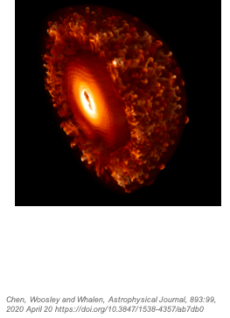World's first 3-D Simulations of Superluminous Supernovae
Science Highlight
April 20, 2020

The nebula phase of the magnetar-powered super-luminous supernova from the team’s 3D simulation. The supernova ejecta has expanded to a size similar to the solar system. Large scale mixing appears at the outer and inner region of ejecta. The resulting light curves and spectra are sensitive to the mixing that depends on stellar structure and the physical properties of magnetar. Credit: Ken Chen
Science Achievement
For the first time ever, an international team of astrophysicists simulated the three-dimensional (3-D) physics of superluminous supernovae — which are about a hundred times more luminous than typical supernovae. They achieved this milestone using Berkeley Lab’s CASTRO code and supercomputers at NERSC.
Significance and Impact
Superluminous supernovae are perhaps the brightest explosions in the universe, but the physics behind these events is not well understood. These new simulations reveal that additional instabilities, not present in ordinary supernovae, occur that help drive the explosion. Their simulations also explain certain observations, like why iron is observed early in core-collapse supernovae events like SN 1987A. This has been a long-standing mystery in astrophysics.
Research Details
The team needed NERSC supercomputers to model the required physics over many scales and in three dimensions. Lower dimensional models can not capture all the important effects, such as fluid instabilities. The observed instabilities drive mixing within the system, which affects how quickly the supernovas brighten and dim and what elements are observed in their spectra.
Related Links
Ken Chen received the NERSC 2015 High Impact Scientific Achievement Early Career Award while a post-doctoral researcher at UC Santa Cruz.
Chen Ke-Jung; Woosley, S. E.; Whalen, Daniel J., "Three-dimensional Simulations of Magnetar-powered Superluminous Supernovae"; ASTROPHYSICAL JOURNAL, 893 2020 APR10.3847/1538-4357/ab7db0
About NERSC and Berkeley Lab
The National Energy Research Scientific Computing Center (NERSC) is a U.S. Department of Energy Office of Science User Facility that serves as the primary high performance computing center for scientific research sponsored by the Office of Science. Located at Lawrence Berkeley National Laboratory, NERSC serves almost 10,000 scientists at national laboratories and universities researching a wide range of problems in climate, fusion energy, materials science, physics, chemistry, computational biology, and other disciplines. Berkeley Lab is a DOE national laboratory located in Berkeley, California. It conducts unclassified scientific research and is managed by the University of California for the U.S. Department of Energy. »Learn more about computing sciences at Berkeley Lab.







